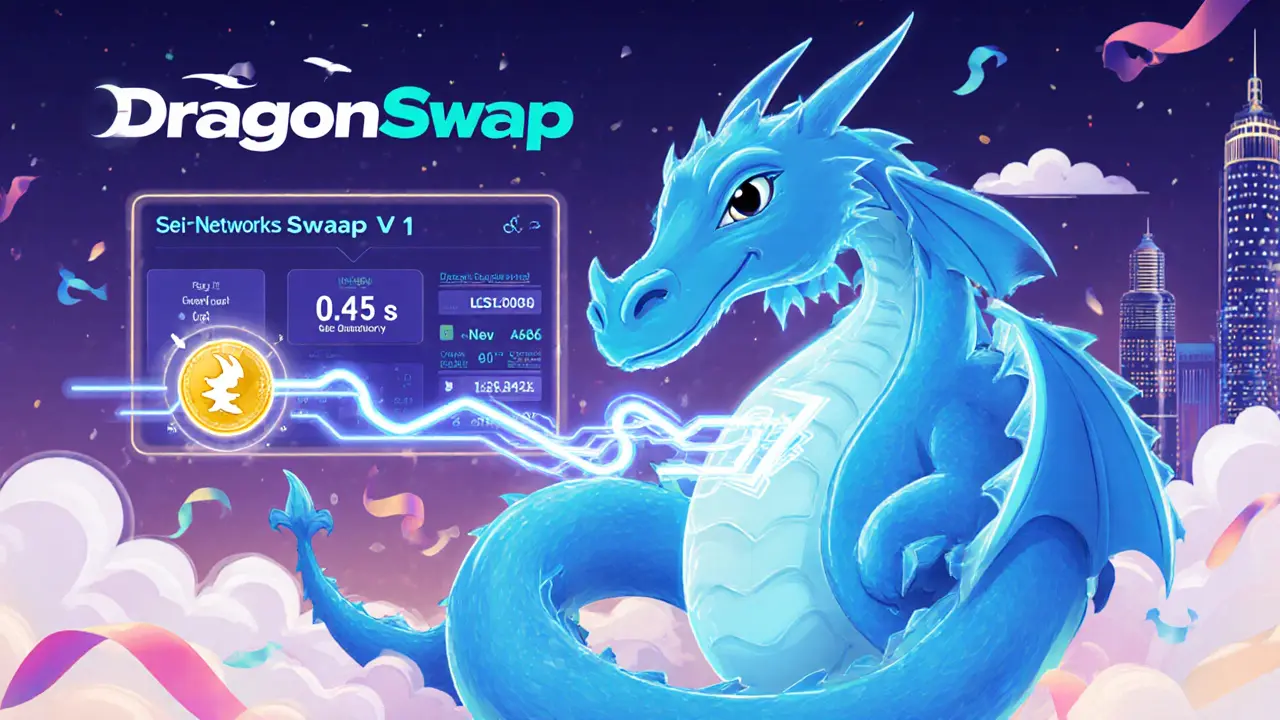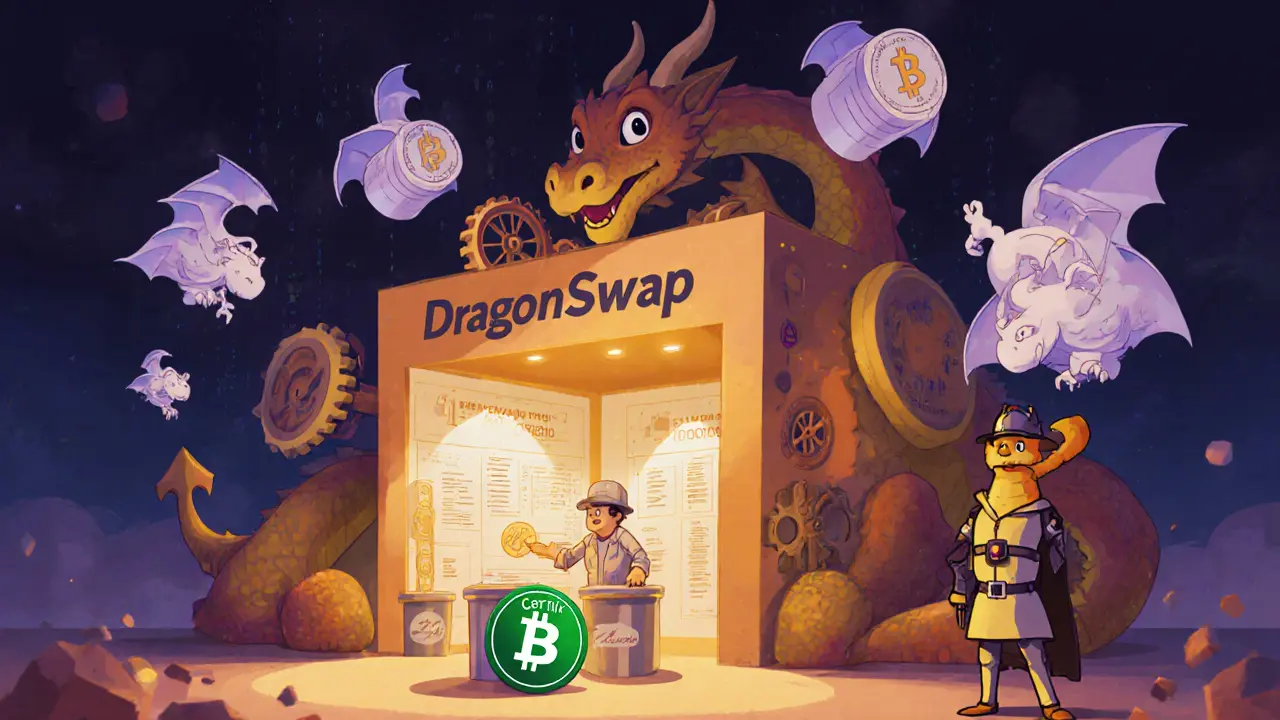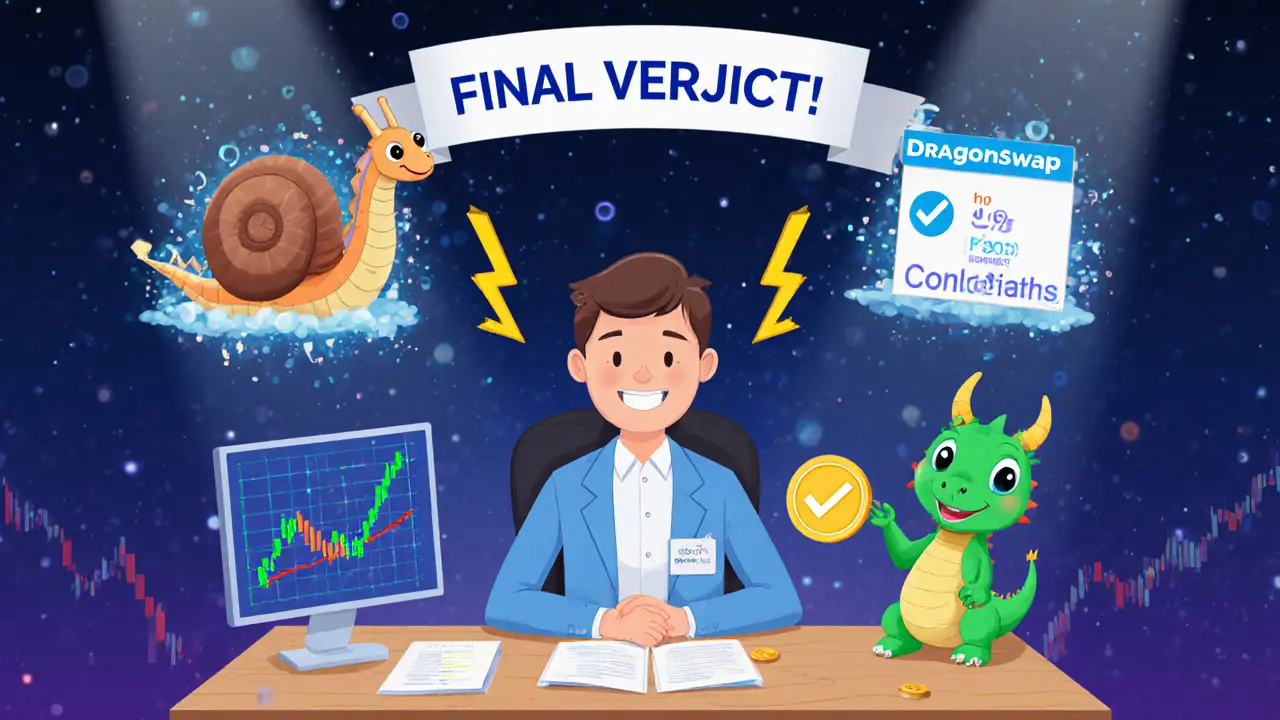 Dec, 19 2024
Dec, 19 2024
DragonSwap Fee Calculator
Calculate Your Trading Savings
Compare DragonSwap's fees with other DEXes to see how much you save
When you’re hunting for a crypto exchange that actually feels instantaneous and cheap, the buzz around DragonSwap V1 catches a lot of attention. It bills itself as the fastest DEX on Sei Network, promising sub‑second swaps and fees that are a fraction of what you’d pay on Ethereum. This review breaks down what the platform does, how it stacks up against the big players, and whether it’s a good fit for regular traders or liquidity providers.
Key Takeaways
- Transaction confirmation averages 400‑600 ms, making it one of the quickest DEXes available.
- Fees sit at 0.3 % per swap - roughly $0.002 per trade at current gas prices.
- Concentrated liquidity boosts capital efficiency by up to 400 % compared to classic AMMs.
- Security is solid after a V1.1 patch that fixed three medium‑severity bugs flagged by CertiK.
- Liquidity depth is still limited; most TVL is tied up in SEI‑USD pairs.
What Is DragonSwap V1?
DragonSwap V1 is a decentralized exchange (DEX) built on the Sei Network’s parallelized EVM. It launched in late 2023 as the first mainnet version of the protocol and serves as the core DeFi hub for the whole Sei ecosystem. The platform aims to give traders the speed of a centralized exchange while keeping everything on‑chain and permissionless.
How It Works - Core Architecture
DragonSwap uses a binary smart‑contract model that separates a singleton factory from individual pair contracts. The factory creates and indexes every token pair, while each pair contract acts as an automated market maker (AMM) and tracks pool balances. This "brutalist" design keeps the attack surface tiny and makes upgrades easier.
Liquidity providers (LPs) can place capital into Concentrated Liquidity a feature that lets LPs allocate funds to a narrow price range rather than the whole curve. By doing so, they capture more fees for the same amount of capital, a benefit that ICOholder quantified as up to four‑fold efficiency gains over traditional constant‑product pools.
Speed and Fees - The Numbers
Speed is DragonSwap’s headline claim. Nansen’s technical analysis (Mar 2024) measured average block confirmation at 450 ms, which is 21‑times faster than Uniswap V3’s ~13 s on Ethereum. During peak hours the DEX processes roughly 14 000 transactions per hour, and the average gas cost is $0.002 - a 99.8 % reduction versus Ethereum’s $1.27 average.
Fees are fixed at 0.3 % per swap. Of that, 0.25 % goes to LPs and 0.05 % to the protocol treasury. This structure mirrors Uniswap’s split but at a dramatically lower absolute cost due to Sei’s cheap gas.

Liquidity Landscape
As of September 2024, DragonSwap holds $87.3 M in total value locked (TVL), representing 43.7 % of all DeFi liquidity on Sei. However, 78 % of that TVL is concentrated in SEI‑USD stablecoin pairs, meaning exotic or long‑tail assets often face shallow depth and higher slippage.
For comparison, Uniswap manages over $10 B in TVL across dozens of chains, giving it far deeper order books. The trade‑off is clear: DragonSwap wins on speed and cost, while larger DEXes win on asset variety.
Security and Audits
The platform’s code underwent a CertiK audit in March 2024. The report uncovered three medium‑severity vulnerabilities related to oracle price validation. All three were patched in the V1.1 update, which also introduced better slippage controls and an enhanced liquid‑staking module.
Since the patch, Nansen has rated DragonSwap 4.2/5 for security and performance. No major exploits have been reported as of October 2025, and the team continues to publish monthly security bulletins.
Wallet Compatibility and On‑boarding
Because DragonSwap lives on Sei’s EVM, you need a wallet that supports the network. The most common choices are Keplr a browser extension that manages Sei and other Cosmos‑based assets, Leap, and Front. New users typically spend 8‑12 minutes configuring their wallet, then three to five swaps to feel comfortable with the UI.
Discord is the main support channel, with an average response time of 22 minutes during business hours. The community Discord hosts over 12 000 members, daily trading chats, and weekly developer office hours.

Comparison with Other DEXes
| Metric | DragonSwap V1 | Uniswap V3 (Ethereum) | PancakeSwap (BNB Chain) |
|---|---|---|---|
| Avg. Confirmation Time | 0.45 s | 13 s | 1.9 s |
| Avg. Gas Fee (USD) | $0.002 | $1.27 | $0.0042 |
| Swap Fee | 0.30 % | 0.30 % | 0.25 % |
| Peak TX/hr | 14 000 | ~1 200 | 3 500 |
| Weekly Active Users (2024) | 42 000 | 1.7 M | 340 000 |
The table shows why high‑frequency traders love DragonSwap - you can execute dozens of arbitrage moves in a few seconds while keeping fees negligible.
Pros & Cons
- Pros
- Sub‑second confirmations make it ideal for bots and scalpers.
- Ultra‑low gas means you can trade small amounts without being eaten by fees.
- Concentrated liquidity gives LPs higher returns on modest capital.
- Solid audit track record after V1.1 patch.
- Cons
- Liquidity is heavily skewed to SEI‑USD pairs; exotic assets suffer.
- No native cross‑chain bridge yet - you’re locked into Sei.
- On‑boarding can be confusing for newcomers unfamiliar with Cosmos‑style wallets.
- Community size is small compared to Ethereum DEXes, which limits third‑party tooling.
Is DragonSwap V1 Right for You?
If you trade high‑volume, low‑margin strategies on Sei‑based tokens, DragonSwap is hard to beat. The speed advantage translates directly into better arbitrage and lower slippage during bursts of activity. For LPs, the concentrated liquidity model can boost yields dramatically, especially on the deep SEI‑USD pool.
However, if you need a wide range of assets, want to hop between chains, or rely on large liquidity pools for big orders, you may still prefer Uniswap or PancakeSwap. DragonSwap’s future roadmap promises cross‑chain support in V2 (Q1 2025), which could close that gap.
Final Verdict
DragonSwap V1 delivers exactly what it promises: lightning‑fast swaps and near‑zero fees on a secure, audited platform. Its main limitation is ecosystem lock‑in, meaning your success hinges on Sei’s growth. For traders and LPs already inside the Sei universe, it’s a must‑try. For the broader crypto crowd, keep an eye on the upcoming V2 upgrade - it could turn a niche DEX into a serious multi‑chain contender.
How do I connect my wallet to DragonSwap V1?
First, install a Sei‑compatible wallet like Keplr, Leap or Front. Open the extension, add the Sei network (the RPC URL is provided in the wallet’s network list), then click “Connect” on DragonSwap’s website. The DEX will prompt you to approve the connection - one click and you’re ready to trade.
What are the fees for swapping on DragonSwap?
The protocol charges a flat 0.3 % per swap. 0.25 % of that goes straight to liquidity providers, and 0.05 % is retained by the treasury. Gas fees on Sei are currently around $0.002 per transaction, which is dramatically lower than Ethereum’s $1‑plus.
Is DragonSwap V1 safe to use?
Yes, after the V1.1 update the platform passed a CertiK audit that fixed three medium‑severity bugs. Ongoing monitoring shows no major exploits. As with any DeFi protocol, keep only what you’re willing to risk and consider using a hardware wallet for large amounts.
Can I provide liquidity on DragonSwap?
Absolutely. Go to the “Liquidity” tab, pick a pair (SEI‑USD is the deepest), and choose a price range for concentrated liquidity. You’ll receive pool tokens that represent your share, which you can redeem anytime.
When is DragonSwap V2 expected?
The roadmap lists a Q1 2025 launch for V2, which will add cross‑chain functionality via Sei’s upcoming interchain accounts. Until then, V1 will remain fully supported.
Irish Mae Lariosa
December 19, 2024 AT 04:54DragonSwap V1 undeniably positions itself as the speed champion within the Sei ecosystem, and that claim is substantiated by the sub‑second confirmation metrics consistently reported across multiple data providers; the average of 450 ms per transaction is not merely a statistical blip but a repeatable performance characteristic that rivals centralized exchange latency. Moreover, the platform’s fee structure, pegged at a flat 0.3 % per swap, translates to a tangible cost advantage when juxtaposed against Ethereum’s typical 0.3 % plus a gas fee that frequently exceeds $1, thereby democratizing access for traders operating with modest capital. The concentrated liquidity model further amplifies capital efficiency, allowing liquidity providers to focus their assets within narrow price bands and harvest up to four times the fee revenue relative to traditional constant‑product pools, a feature that is both innovative and financially compelling. Security considerations have also been addressed through a CertiK audit that identified three medium‑severity vulnerabilities, all of which were remediated in the V1.1 patch, ensuring that the attack surface remains minimal and that the platform’s codebase is resilient against common exploit vectors. While the overall TVL of $87.3 M may appear modest when compared to multi‑billion dollar ecosystems, it nonetheless reflects a concentrated user base that is heavily invested in SEI‑USD pairs, providing deep liquidity for the most traded assets on the network.
Operationally, the DEX’s binary smart‑contract architecture simplifies upgrade pathways and reduces the likelihood of emergent bugs, a design philosophy that aligns well with the broader industry trend toward modular, upgradable contracts. From a user onboarding perspective, the necessity of a Sei‑compatible wallet such as Keplr adds a layer of friction for newcomers, yet the community support channels, particularly the Discord with its average 22‑minute response time, mitigate this hurdle effectively. The platform’s ability to process roughly 14 000 transactions per hour during peak periods demonstrates not only raw throughput but also a healthy demand for rapid trade execution, which is essential for arbitrageurs and high‑frequency trading strategies.
In comparative terms, Uniswap V3’s 13‑second average confirmation time and PancakeSwap’s 1.9‑second latency underscore DragonSwap’s superior performance, while the fee differential-$0.002 versus $0.0042 on PancakeSwap and $1.27 on Ethereum-highlights a cost structure that is virtually unparalleled in today’s DeFi landscape. However, the concentration of liquidity in SEI‑USD pairs also introduces a trade‑off: users seeking exposure to more niche assets may encounter shallow depth and elevated slippage, a limitation that the upcoming V2 release promises to address through cross‑chain bridging capabilities slated for Q1 2025.
Overall, the platform delivers on its core promises of speed, low cost, and security, making it an attractive venue for traders already entrenched in the Sei ecosystem; for those outside of it, the ecosystem lock‑in remains a significant consideration, but the roadmap suggests a strategic expansion that could broaden its appeal considerably.
Carolyn Pritchett
December 19, 2024 AT 10:20Honestly, DragonSwap sounds like another hype‑pump that forgets the real issue: fragmented liquidity. Sure, you get sub‑second swaps, but if the order books are thin, those speeds mean nothing when you hit a 5‑pixel slippage. The 0.3 % fee is modest, yet you’re still paying for a platform that only supports SEI‑USD pairs effectively. Until they broaden the asset pool, most traders will keep their eyes on Uniswap where depth actually matters.
Cecilia Cecilia
December 20, 2024 AT 14:06The audit report shows the platform is safe for typical use. Keep only what you can afford to lose.
Ikenna Okonkwo
December 20, 2024 AT 15:30While the security audit gives confidence, it's also worth noting that the community support is surprisingly responsive, which can help newcomers navigate the wallet setup. The fast confirmation times are a genuine advantage for those running arbitrage bots, and the low gas fees open the door for smaller traders. Even though the liquidity is concentrated, that very concentration can lead to higher yields for LPs willing to stake in the deep SEI‑USD pool. Overall, the platform balances speed and accessibility nicely, offering a solid entry point into Sei DeFi.
Nick O'Connor
December 21, 2024 AT 17:53DragonSwap's interface, while sleek, still demands a few extra steps; you must first install a compatible wallet, add the Sei network, and then approve the connection-each of these actions, though straightforward, can trip up those unfamiliar with Cosmos‑style ecosystems, especially when the documentation assumes prior experience.
Hailey M.
December 21, 2024 AT 18:43Oh, look at you, bragging about sub‑second trades while the rest of us are still figuring out how to click "Connect" without breaking a sweat 😂. If you wanted to impress us, maybe show some real depth beyond the SEI‑USD pair, huh? 🙄
Vinoth Raja
December 22, 2024 AT 21:40From a protocol design angle, the binary factory‑pair architecture is a tidy abstraction, but the passive takedown of cross‑chain bridges keeps the ecosystem siloed, which could throttle network effects in the long run.
Matthew Theuma
December 22, 2024 AT 22:13True that the design is clean, but the user‑experience can feel a bit clunky at times 😊. Still, the sub‑second swaps are impressive! 🚀
Jason Zila
December 24, 2024 AT 01:26Speed matters, but without diverse liquidity the platform will always be a niche player. The upcoming V2 could change that if cross‑chain support lands as promised.
Devi Jaga
December 24, 2024 AT 01:35Sure, V2 will fix everything, just like every other "future update" that never arrives.